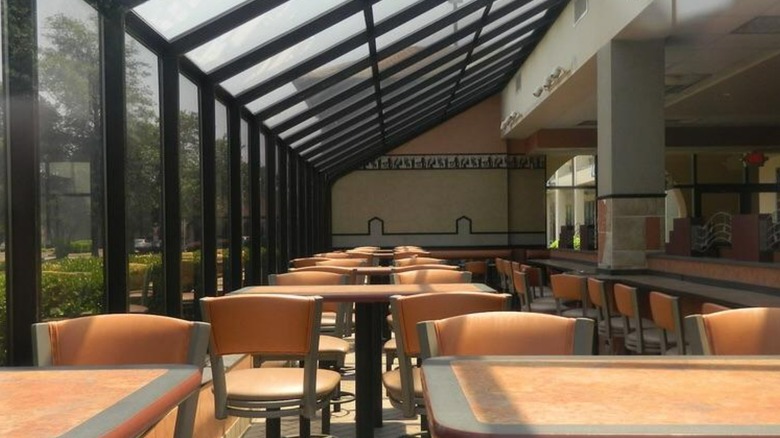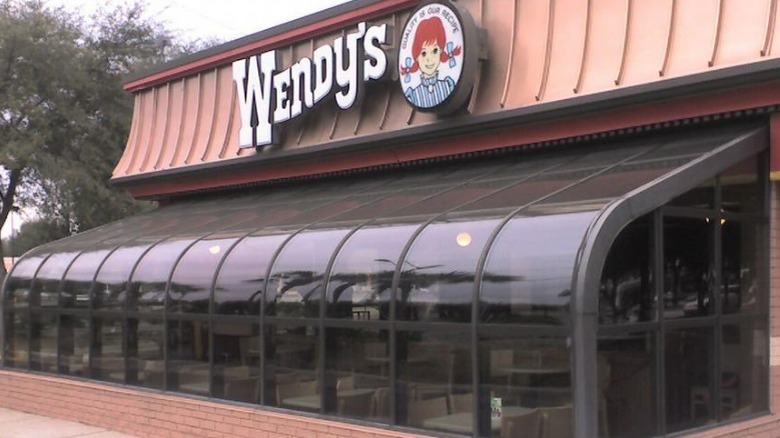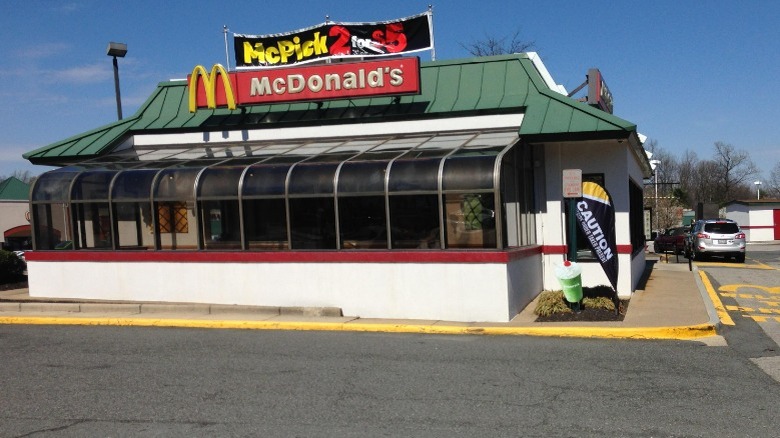Why Did Fast Food Restaurants Once Have Sunrooms?
If you were to go into any fast-food restaurant now, chances are you're not standing in the same restaurant as it was in the 1980s or 1990s. While your local McDonald's may have been on the block since 1984, it doesn't look anything like it did when it first opened. Just as cars, fashion, and technology have changed with the times, so too does the fast-food industry.
Taco Bell once sported a "Miami Vice"- Esque Memphis design of geometric shapes and neon colors (via Architectural Digest) rather than the ultra-modern interior of muted colors and digital ordering screens. Vox laments the "boring" design of modern-day McDonald's, harking back to the days of bright red and yellow theming and playful McDonaldland-themed interiors. In some cases, some fast-food restaurants still have their "retro" decor, as one user on Reddit found a Burger King that still has an interior right out of the late 1990s. While you could hold a debate on whether this is a case of modernization stripping away the character and charm these places had, the fact is that with time comes changes, and certain trends fade away, leaving only architectural fossils in their place.
Perhaps one of the most interesting trends in fast-food architecture of the time was the use of sunrooms — big indoor rooms with wall-to-roof windows that allowed sunlight to flood in through the ceiling and the walls. Why exactly did fast-food places, known for their cheap and greasy food, ever have such a feature?
Sunrooms created an upscale atmosphere
It's no secret that many people believe fast-food restaurants to be the farthest thing from an upscale or high-class restaurant. While this may be true, this isn't to say that certain restaurants didn't try to give the appearance of looking "refined." Although the industry couldn't exactly serve up filet mignon and cabernet, it could make its locations look classy and welcoming — and what's more classy than dining inside a spacious naturally lit sunroom?
As a 1985 report from The New York Times explains, it was sort of like "putting a tuxedo on a hillbilly." Many fast-food restaurants, eager to present an upscale and warm image, were adding everything from hanging plants to wood paneling and sunrooms.
Denny Lynch, then-vice president of communications for Wendy's, told The NYT the sunroom offers two distinct advantages. Its bright, open concept means people on the street can look in and see how many customers are enjoying Wendy's food and it allows the location to have hanging decorations to further increase that ritzy atmosphere. But while Wendy's added sunrooms to most of its restaurants, McDonald's is credited with introducing the idea to the industry first. Mel Magazine directs us to a 1985 report from The Chicago Tribune, which details how an Illinois McDonald's first set up a sunroom to compete with another restaurant that also boasted one.
But if sunrooms supposedly give a high-class and sophisticated atmosphere, why did they fall out of favor? Why stop trying to appear upscale anyway?
Sunrooms just became outdated
Remember earlier what we said about time marching on? While sprawling sunrooms, hanging plants, and wood paneling may have been the norm of fast-food restaurants in the late 1980s and 1990s, cultural tastes shift over time so these once-popular features became quickly outdated. Curbed writer Nate Berg explains that, much like someone updating their wardrobe, fast-food restaurants have to do some pretty major renovations every so often to get with the times. Who wants a sunroom when the data shows that the people want "industrial modern chic?" or "fast-casual."
The idea of looking more refined and upscale, however, is still a present theme in the industry. Business Insider explains that fast-food restaurants nowadays seek to leave behind their "kitschy" and cheesy designs and adopt a more ultra-modern look of cube designs, minimalism, and glass and steel. Not only would this have the supposed benefit of adapting to mobile or drive-thru orders much easier and being cheaper to build to boot, but it also gives the restaurant a "contemporary" look. Gone are the days of fast-food mascots and zany designs, for these restaurants have "grown up."
Of course, there are those who believe that the industry was much better when it focused more on sunrooms and a "luxurious" customer experience. In fact, one individual has even created a petition to demand Wendy's return sunrooms back to its restaurants. It seems that, for some, the so-called good old days truly were the better days.


